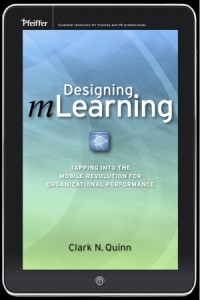I’ve been thinking on LXD for a while now, not least because I’ve an upcoming workshop at DevLearn in Lost Wages in October. And one of the things I’ve been thinking about are the tools we use for LXD. I’ve created diagrams (such as the Education Engagement Alignment), and quips, but here I’m thinking something else. We know that job aids are helpful; things like checklists, and decision trees, and lookup tables. And I’ve created some aids for the Udemy course on deeper elearning I developed. But here I want to know what you are using as tools for LXD? How do you use external resources to keep your design on track?
The simple rationale, of course, is that there are things our brains are good at, and things they’re not. We are pattern-matchers and meaning-makers, naturally making up explanations for things that happen. We’re also creative, finding solutions under constraints. Our cognitive architecture is designed to do this; to help us adapt to the first-level world we evolved in.
However, our brains aren’t particularly good at the second-level world we have created. Complex ideas require external representation. We’re bad at remembering rote and arbitrary steps and details. We’re also bad at complex calculations. This makes the case for tools that help scaffold these gaps in our cognition.
And, in particular, for design. Design tends to involve complex responses, in this case in terms of an experience design. That maps out over content, time, and tools. Consequently, there are opportunities to go awry. Therefore, tools are a plausible adjunct.
You might be using templates for good design. Here, you’d have a draft storyboard, for instance, that insures you’re including a meaningful introduction, causal conceptual model, examples, etc. Or you might have a checklist that details the elements you should be including. You could have a model course that you use as a reference.
My question, to you, is what tools are you using to increase the likelihood of a quality design, and how are they working for you? I’d like to know what you’ve found helpful as tools for LXD, as I look to create the best support I can. Please share!

